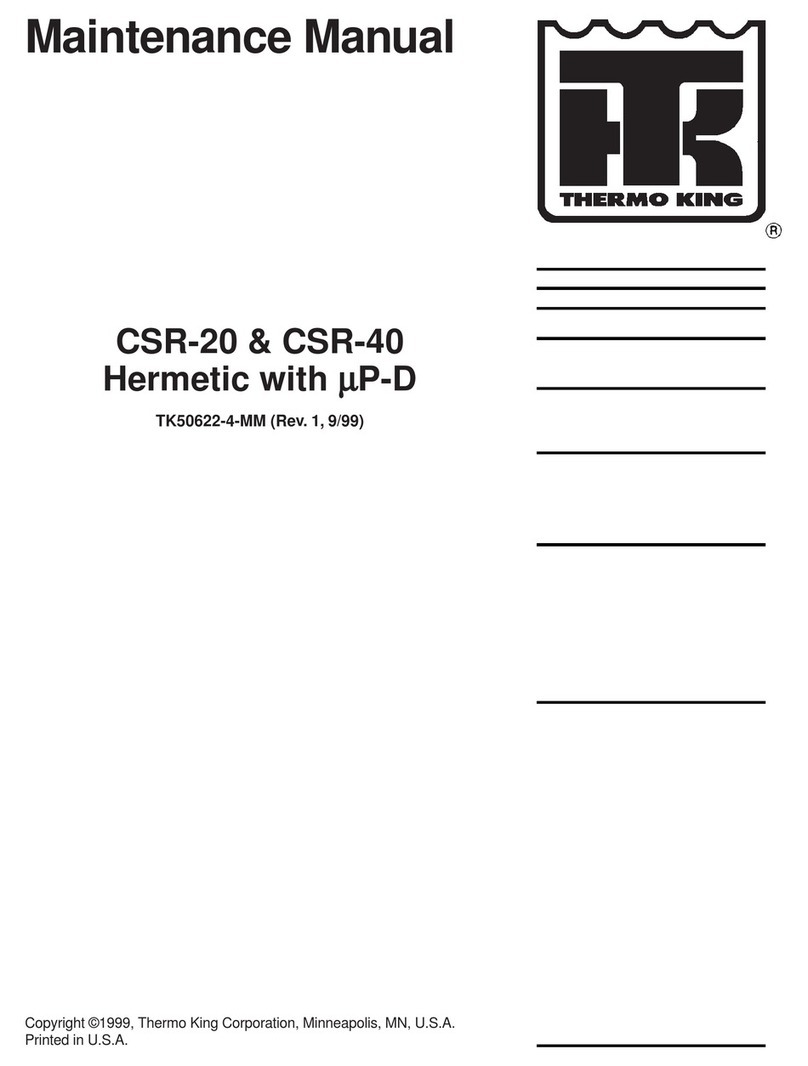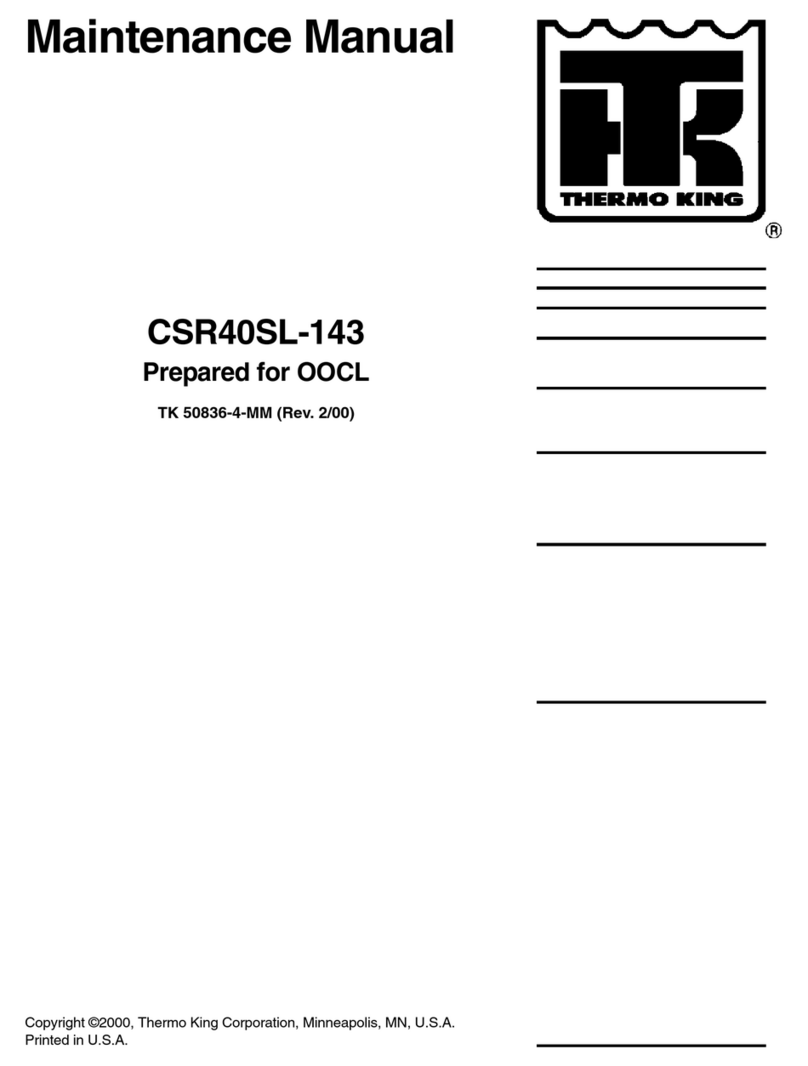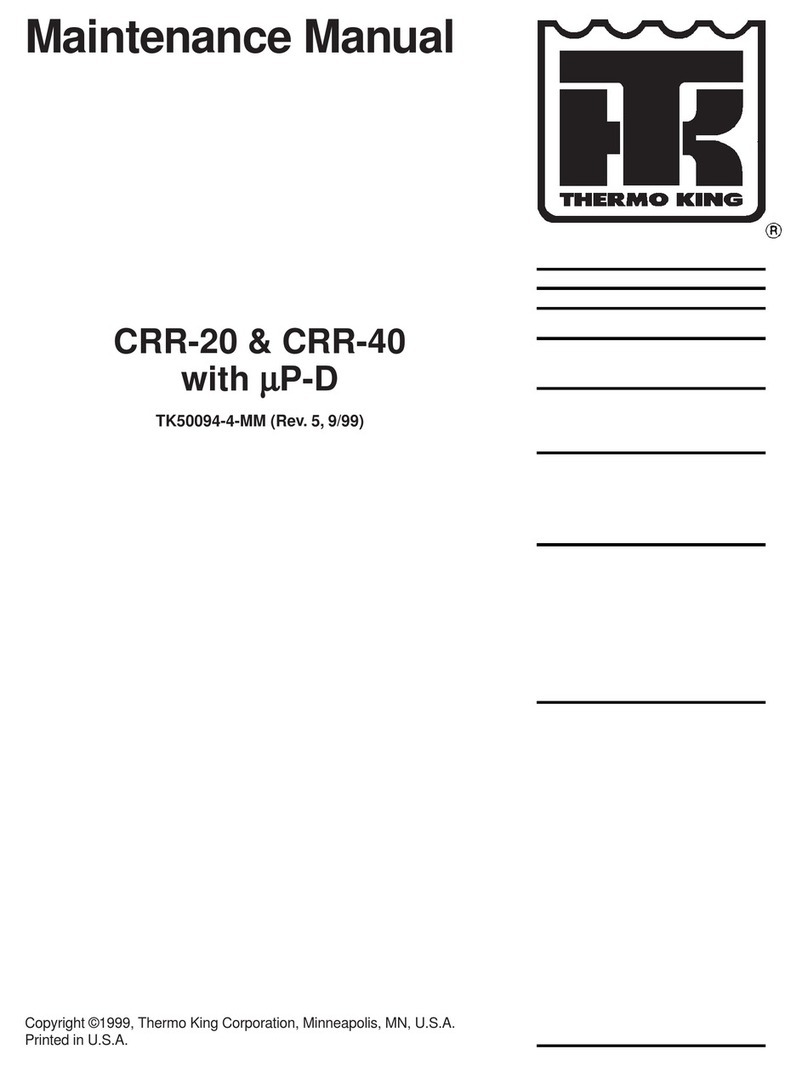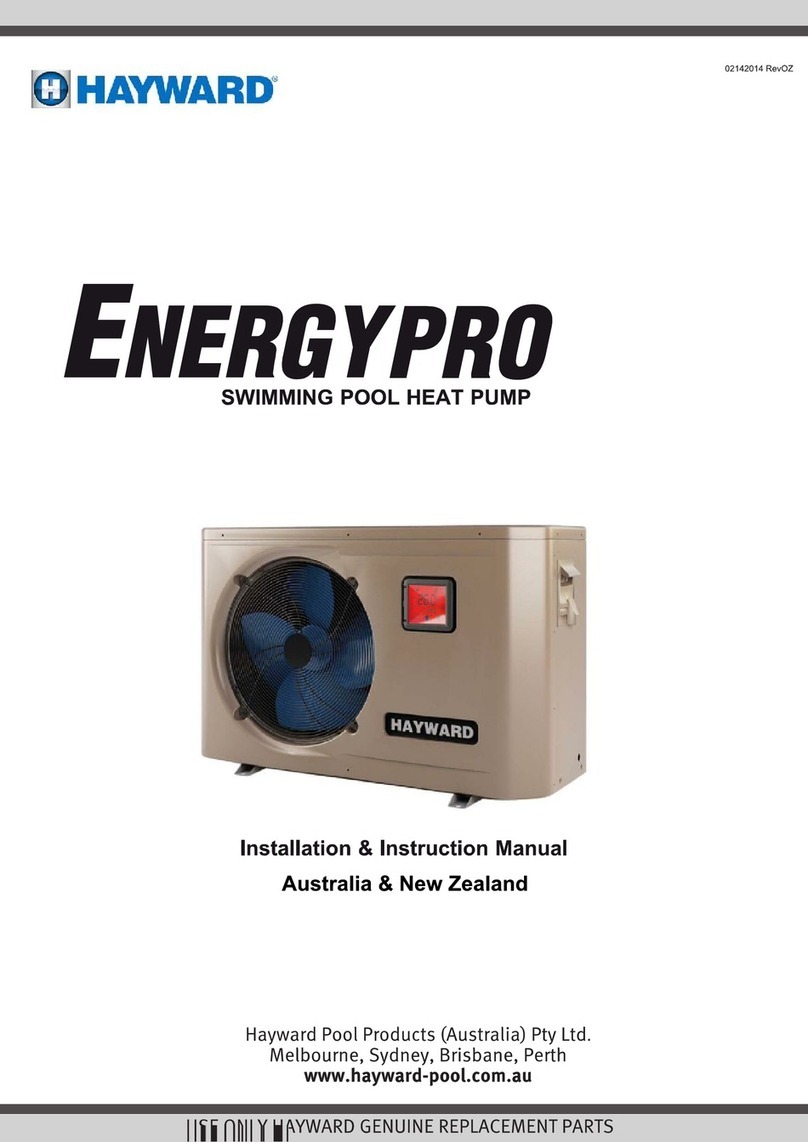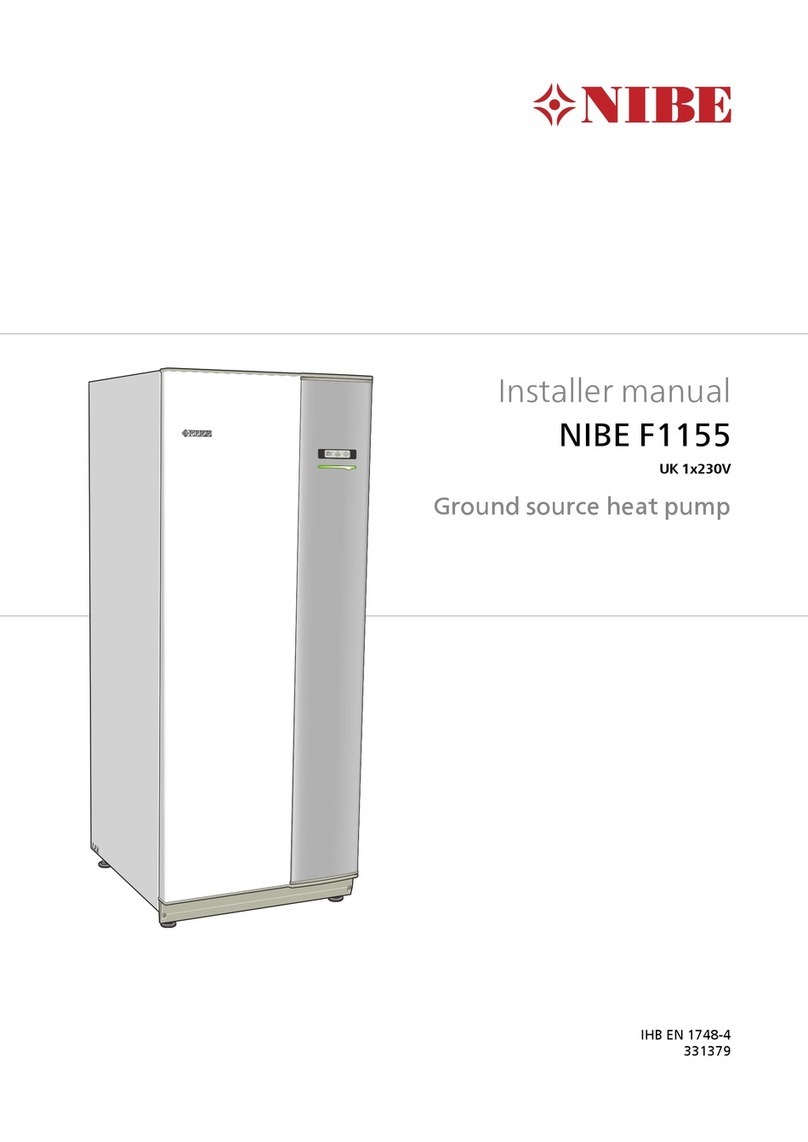Thermo King Ce-Series User manual

Ce-Series Operator’s Manual
TK 60980-ML-18-OP (Rev. 3, 04/16)

2
LANGUAGES
English. . . . . . . . . . . . . . . . . . . . . . . . . . . . . . . . . . . . . . . . . . . . . . . . . . . . . . . . . . . . . . . . . . . . . . . . . . . . . . . 3
Français. . . . . . . . . . . . . . . . . . . . . . . . . . . . . . . . . . . . . . . . . . . . . . . . . . . . . . . . . . . . . . . . . . . . . . . . . . . . . 21
Deutsch . . . . . . . . . . . . . . . . . . . . . . . . . . . . . . . . . . . . . . . . . . . . . . . . . . . . . . . . . . . . . . . . . . . . . . . . . . . . . 39
Español . . . . . . . . . . . . . . . . . . . . . . . . . . . . . . . . . . . . . . . . . . . . . . . . . . . . . . . . . . . . . . . . . . . . . . . . . . . . . 57
Italiano . . . . . . . . . . . . . . . . . . . . . . . . . . . . . . . . . . . . . . . . . . . . . . . . . . . . . . . . . . . . . . . . . . . . . . . . . . . . . . 75
Nederlands . . . . . . . . . . . . . . . . . . . . . . . . . . . . . . . . . . . . . . . . . . . . . . . . . . . . . . . . . . . . . . . . . . . . . . . . . . 93
Português . . . . . . . . . . . . . . . . . . . . . . . . . . . . . . . . . . . . . . . . . . . . . . . . . . . . . . . . . . . . . . . . . . . . . . . . . . 111
Русский . . . . . . . . . . . . . . . . . . . . . . . . . . . . . . . . . . . . . . . . . . . . . . . . . . . . . . . . . . . . . . . . . . . . . . . . . . . . 129
Polski . . . . . . . . . . . . . . . . . . . . . . . . . . . . . . . . . . . . . . . . . . . . . . . . . . . . . . . . . . . . . . . . . . . . . . . . . . . . . . 147
Magyar . . . . . . . . . . . . . . . . . . . . . . . . . . . . . . . . . . . . . . . . . . . . . . . . . . . . . . . . . . . . . . . . . . . . . . . . . . . . . 165
Česky . . . . . . . . . . . . . . . . . . . . . . . . . . . . . . . . . . . . . . . . . . . . . . . . . . . . . . . . . . . . . . . . . . . . . . . . . . . . . . 183
Dansk. . . . . . . . . . . . . . . . . . . . . . . . . . . . . . . . . . . . . . . . . . . . . . . . . . . . . . . . . . . . . . . . . . . . . . . . . . . . . . 201
Ελληνικά . . . . . . . . . . . . . . . . . . . . . . . . . . . . . . . . . . . . . . . . . . . . . . . . . . . . . . . . . . . . . . . . . . . . . . . . . . . 219
Română. . . . . . . . . . . . . . . . . . . . . . . . . . . . . . . . . . . . . . . . . . . . . . . . . . . . . . . . . . . . . . . . . . . . . . . . . . . . 237
Türkçe . . . . . . . . . . . . . . . . . . . . . . . . . . . . . . . . . . . . . . . . . . . . . . . . . . . . . . . . . . . . . . . . . . . . . . . . . . . . . 255

Ce-Series Operator’s Manual
TK 60980-EN-18-OP (Rev. 3, 04/16)

4
ENGLISH TABLE OF CONTENTS
Introduction . . . . . . . . . . . . . . . . . . . . . . . . . . . . . . . . . . . . . . . . . . . . . . . . . . . . . . . . . . . . . . . . . . . . . . . . . . . . . . . . . . . 5
General Operation . . . . . . . . . . . . . . . . . . . . . . . . . . . . . . . . . . . . . . . . . . . . . . . . . . . . . . . . . . . . . . . . . . . . . . . . . . . . . . . . .6
Safety Precautions . . . . . . . . . . . . . . . . . . . . . . . . . . . . . . . . . . . . . . . . . . . . . . . . . . . . . . . . . . . . . . . . . . . . . . . . . . . . . 7
Refrigerant . . . . . . . . . . . . . . . . . . . . . . . . . . . . . . . . . . . . . . . . . . . . . . . . . . . . . . . . . . . . . . . . . . . . . . . . . . . . . . . . . . . . . . .7
First aid - Refrigerant . . . . . . . . . . . . . . . . . . . . . . . . . . . . . . . . . . . . . . . . . . . . . . . . . . . . . . . . . . . . . . . . . . . . . . . . . . . . . . .7
Refrigerant Oil . . . . . . . . . . . . . . . . . . . . . . . . . . . . . . . . . . . . . . . . . . . . . . . . . . . . . . . . . . . . . . . . . . . . . . . . . . . . . . . . . . . .7
First aid - Refrigerant Oil . . . . . . . . . . . . . . . . . . . . . . . . . . . . . . . . . . . . . . . . . . . . . . . . . . . . . . . . . . . . . . . . . . . . . . . . . . . .7
Auto Start . . . . . . . . . . . . . . . . . . . . . . . . . . . . . . . . . . . . . . . . . . . . . . . . . . . . . . . . . . . . . . . . . . . . . . . . . . . . . . . . . . . . . . . .8
Electrical Hazard . . . . . . . . . . . . . . . . . . . . . . . . . . . . . . . . . . . . . . . . . . . . . . . . . . . . . . . . . . . . . . . . . . . . . . . . . . . . . . . . . .8
Electronic Control System . . . . . . . . . . . . . . . . . . . . . . . . . . . . . . . . . . . . . . . . . . . . . . . . . . . . . . . . . . . . . . . . . . . . . . . 9
Description of the Electronic Control System. . . . . . . . . . . . . . . . . . . . . . . . . . . . . . . . . . . . . . . . . . . . . . . . . . . . . . . . . . . . .9
Unit Controls. . . . . . . . . . . . . . . . . . . . . . . . . . . . . . . . . . . . . . . . . . . . . . . . . . . . . . . . . . . . . . . . . . . . . . . . . . . . . . . . . . . . .10
Operating Instructions . . . . . . . . . . . . . . . . . . . . . . . . . . . . . . . . . . . . . . . . . . . . . . . . . . . . . . . . . . . . . . . . . . . . . . . . . 11
Weekly Pre-trip Inspection . . . . . . . . . . . . . . . . . . . . . . . . . . . . . . . . . . . . . . . . . . . . . . . . . . . . . . . . . . . . . . . . . . . . . . . . . .11
Starting the Unit . . . . . . . . . . . . . . . . . . . . . . . . . . . . . . . . . . . . . . . . . . . . . . . . . . . . . . . . . . . . . . . . . . . . . . . . . . . . . . . . . .12
Standard Display . . . . . . . . . . . . . . . . . . . . . . . . . . . . . . . . . . . . . . . . . . . . . . . . . . . . . . . . . . . . . . . . . . . . . . . . . . . . . . . . .12
Entering the Setpoint Temperature . . . . . . . . . . . . . . . . . . . . . . . . . . . . . . . . . . . . . . . . . . . . . . . . . . . . . . . . . . . . . . . . . . .12
Initiating the Evaporator Manual Defrost Cycle . . . . . . . . . . . . . . . . . . . . . . . . . . . . . . . . . . . . . . . . . . . . . . . . . . . . . . . . . .13
Alarms . . . . . . . . . . . . . . . . . . . . . . . . . . . . . . . . . . . . . . . . . . . . . . . . . . . . . . . . . . . . . . . . . . . . . . . . . . . . . . . . . . . . . . . . .13
Alarm Code Descriptions . . . . . . . . . . . . . . . . . . . . . . . . . . . . . . . . . . . . . . . . . . . . . . . . . . . . . . . . . . . . . . . . . . . . . . . . . . .14
Clearing Alarm Codes . . . . . . . . . . . . . . . . . . . . . . . . . . . . . . . . . . . . . . . . . . . . . . . . . . . . . . . . . . . . . . . . . . . . . . . . . . . . .14
Viewing Information Screens . . . . . . . . . . . . . . . . . . . . . . . . . . . . . . . . . . . . . . . . . . . . . . . . . . . . . . . . . . . . . . . . . . . . . . . .14
Post-Start Inspection . . . . . . . . . . . . . . . . . . . . . . . . . . . . . . . . . . . . . . . . . . . . . . . . . . . . . . . . . . . . . . . . . . . . . . . . . . . . . .15
Loading Procedure. . . . . . . . . . . . . . . . . . . . . . . . . . . . . . . . . . . . . . . . . . . . . . . . . . . . . . . . . . . . . . . . . . . . . . . . . . . . . . . .15
Procedure after loading . . . . . . . . . . . . . . . . . . . . . . . . . . . . . . . . . . . . . . . . . . . . . . . . . . . . . . . . . . . . . . . . . . . . . . . . . . . .15
Weekly Pre-Trip Checks. . . . . . . . . . . . . . . . . . . . . . . . . . . . . . . . . . . . . . . . . . . . . . . . . . . . . . . . . . . . . . . . . . . . . . . . . . . .15
Weekly Post-Trip Checks. . . . . . . . . . . . . . . . . . . . . . . . . . . . . . . . . . . . . . . . . . . . . . . . . . . . . . . . . . . . . . . . . . . . . . . . . . .15
Inspection Maintenance Schedule. . . . . . . . . . . . . . . . . . . . . . . . . . . . . . . . . . . . . . . . . . . . . . . . . . . . . . . . . . . . . . . . 16
Warranty. . . . . . . . . . . . . . . . . . . . . . . . . . . . . . . . . . . . . . . . . . . . . . . . . . . . . . . . . . . . . . . . . . . . . . . . . . . . . . . . . . . . . 19

5
INTRODUCTION
THERMO ASSISTANCE
Thermo Assistance is a multilingual
communication tool designed to put you in direct
contact with an authorised Service Dealer should
you require one.
To use this system, you need the following
information before you call:
• Contact Phone Number
• Type of TK Unit
• Thermostat Setting
• Present Load Temperature
• Probable Cause of Fault
• If the Unit is Under Warranty
• How You Will Pay for the Repair
Refer to the Thermo King Service Directory.
Give the Thermo Assistance Operator your name
and a contact phone number and ask the operator
to call you back. Thermo Assistance will then call
you back, at which point you can give details of
the service required and the repair will be
organised.
Please note that Thermo Assistance cannot
guarantee payments and that the service is
designed for the exclusive use of refrigerated
transporters using products manufactured by
Thermo King Corporation.
INTRODUCTION
Thermo King Spain has developed a new digital
Control Box with a programmable microprocessor
that monitors the operation of the unit and
displays this information rapidly and clearly on
the screen.
These new In-cab Control Boxes have been
designed for use in Thermo King eC-Series units.
There is nothing complicated about learning to
use the In-cab Control Boxes manufactured by
Thermo King Spain, but you will find that a few
minutes spent studying the contentsof this manual
will be time well spent.
The In-cab Control Boxes can operate with both
12 and 24V units.
Temperatures can be displayed in either degrees
Celsius or degrees Fahrenheit.
This driver’s manual is published for information
purposes only and the information being furnished
herein should not be considered as all-inclusive
or meant to cover all contingencies. If
further information is required, consult your
Thermo King Service Directory for the location
and phone number of your local dealer.
All service requirements, major and minor, should
be handled by a Thermo King dealer for four very
important reasons:
1. They are equipped with the factory
recommended tools to perform all service
functions.
2. They have factory trained and certified
technicians.
DISCLAIMER
The manufacturer, Thermo King Corporation,
assumes no responsibility for any act or action
taken on the part of the owner or operator in the
repair or operation of the products covered by
this manual that are contrary to the
manufacturer’s printed instructions. No
warranties express or implied, including
warranties arising from cause of dealing or usage
or trade, are made regarding the information,
recommendations, and description contained
herein. The manufacturer is not responsible and
will not be held liable in contract or in tort
(including negligence) for any special, indirect,
or consequential damages, including injury or
damage caused to vehicles, contents, or persons,
by reason of the installation of any Thermo King
product, its mechanical failure, or the failure of
the owner/operator to heed caution and safety
decals strategically located on the product.

6
INTRODUCTION
3. They are stocked with genuine Thermo King
replacement parts.
4. The warranty on your new unit is valid when
the repair and/or replacement of component
parts is performed by an Authorised
Thermo King dealer.
Performing pre-trip checks on a regular basis will
minimise “on the road” operating problems. A
closely followed maintenance program will also
help keep your unit in top operating condition.
If factory recommended procedures are followed,
you will learn that you have purchased the most
efficient and dependable temperature
control system available.
GENERAL OPERATION
In truck-driven units, temperature control is based
on two values: The setting (Setpoint) of the
electronic thermostat and the evaporator return
temperature. The difference between these two
temperatures will determine the mode of
operation: cool, heat, or null.
•Cool: When the temperature in the load
compartment is higher than the setpoint, the
unit runs in cool mode to reduce the evaporator
return temperature.
•Heat: When the temperature in the load
compartment is lower than the setpoint, the unit
changes to heat mode to raise the evaporator
return temperature.
•Null: Once the Setpoint Temperature has been
reached, and while the temperature remains
between XºC/F above or below the setpoint,
there is no demand for transfer of heat or cold,
and the unit runs in null mode.
•Defrost: After a scheduled period of time in
cool mode, between 30 minutes and 8 hours,
the unit runs in this fourth mode of operation to
eliminate ice that has accumulated in the
evaporator or condenser coil. Defrost can be
initiated automatically or manually.
Factory setting for X is 3ºC (5ºF). During unit
installation, this value can be adjusted in
increments of 1ºC/F.
Units with R-134a refrigerant without defrost:
Temperatures can be controlled from 0ºC to
+22ºC (+32ºF to +71ºF).
Units with R-134a refrigerant with defrost:
Temperatures can be controlled from -10ºC to
+22ºC (+14ºF to +71ºF).
Units with R-404A refrigerant: Temperatures
can be controlled from -32ºC to +22ºC
(-26ºF to +71ºF).
Address:
Sant Josep, 140-142 P.I. “El
Pla”, Sant Feliu de Llobregat,
Barcelona, Spain.
Year of manufacture: Reference Serial Plate.
Installation and commissioning are to be carried
out by an authorised Thermo King Dealer in
accordance with Thermo King procedures and
drawings. Exceptions to this with the written
authorisation of the manufacturer only.
Decrease in
Temperature
Temperature
Setpoint
Increase in
temperature
XºC/F above the
setpoint
XºC/F below the
setpoint
COOL
HEAT
NULL
MODE

7
SAFETY PRECAUTIONS
SAFETY PRECAUTIONS
WARNING!
This unit is not intended for use by persons
(including children) with a physical, sensory or
mental impairment, or by persons without the
proper experience or knowledge, unless they
have been provided supervision or instruction
regarding the use of the unit by a person
responsible for their safety.
Children must be supervised to ensure they do
not play with the unit.
Thermo King recommends that all services be
performed by a Thermo King dealer. However,
there are several general safety practices which
you should be aware of:
1. When working with or around the refrigeration
system, always wear goggles or safety glasses.
Refrigerant or battery acid can cause permanent
damage if they come in contact with your eyes.
2. Never run the unit with the compressor
discharge valve closed.
3. Keep your hands and loose clothing clear of
fans and belts at all times when the unit is
running or when opening and closing the
compressor service valves.
4. If you need to drill holes in your unit for any
reason, use extreme caution. You could be
weakening structural components. Drilling into
electrical wiring or refrigerant lines could cause
a fire.
5. It is recommended that any service work on
evaporator or condenser coils be left for the
certified Thermo King technician but, should
you need to work around the coils, use extreme
caution as exposed coil fins can cause painful
lacerations.
REFRIGERANT
Although fluorocarbon refrigerants are classified
as safe, observe caution when working with
refrigerants or around areas where they are being
used in the servicing of your unit.
Fluorocarbon refrigerants evaporate rapidly,
freezing anything they contact if accidentally
released into the atmosphere from the liquid state.
The Fluorocarbon refrigerants used in the air
conditioning units may produce toxic gases
which, in the presence of an open flame or
electrical short, become severe respiratory
irritants capable of causing death.
FIRST AID - REFRIGERANT
EYES: If liquid comes into contact with the eyes,
flush with large amounts of water and get prompt
medical attention.
SKIN: Flush affected area with large amounts of
lukewarm water and keep cool. Cover burns with
dry, sterile, bulky dressings to protect from
infection or injury. Get medical attention.
INHALATION: Move victim to fresh air and
restore breathing if necessary. Stay with victim
until arrival of emergency medical personnel.
REFRIGERANT OIL
Always observe the following directions when
working with refrigerant oil:
EYES: Do not allow refrigerant oil to contact
your eyes.
SKIN: Do not allow prolonged or repeated contact
with skin or clothing.
IRRITATION: To prevent irritation, wash
thoroughly immediately after handling.
FIRST AID - REFRIGERANT OIL
EYES: Immediately flush eyes with large amounts
of water for at least 15 minutes while holding the
eyelids open. Get prompt medical attention.
SKIN: Remove contaminated clothing. Wash
thoroughly with soap and water. Get medical
attention if the irritation persists.
INHALATION: Move victim to fresh air and
restore breathing if necessary. Stay with victim
until arrival of emergency personnel.
INGESTION: Do not induce vomiting. Contact
local poison control centre or physician
immediately.

8
SAFETY PRECAUTIONS
Fluorocarbon refrigerants tend to displace air and
can cause oxygen depletion which could result in
death by suffocation. Observe caution at all times
when working with or around refrigerants, or air
conditioning systems containing refrigerants,
especially in enclosed or confined areas.
AUTO START
Thermo King truck powered refrigeration units
may start up automatically at any time.
Ensure that the unit is switched off before
inspecting any component part.
ELECTRICAL HAZARD
Ensure that high voltage energy supply is
switched off and disconnect the electric cable
before working on the unit. Units with electrical
power supply present a potential electrical hazard.
WARNING
Electric welding generates high ampere
currents which can damage electrical and
electronic components. To minimise damage,
prior to any welding operation on the vehicle,
the microprocessor controller and unit battery
must be electrically disconnected from
the vehicle. Turn off the microprocessor’s
On/Off switch. Remove the battery negative
cable. Remove all connectors from the rear of
the microprocessor controller. Close the
control box. Connect the welder ground cable
as close as possible to the area being welded.
When welding is complete, remove the welder
ground cable. Reconnect the cables to the rear
of the microprocessor controller. Reconnect
the battery negative cable. Turn on the
microprocessor’s On/Off switch. Reset all
alarms and codes to their previous settings.
Run a full Pre-trip Inspection. Detailed
instructions can be found in Thermo King
Service Procedure A26A.

9
ELECTRONIC CONTROL SYSTEM
ELECTRONIC CONTROL
SYSTEM
Thermo King direct drive refrigeration units are
composed of a condenser unit, an evaporator
unit, a vehicle compressor and a control panel (In-
cab Control Box) which operates the unit.
The Electronic Control System is composed of an
Electronic Control Module (located inside the
condenser unit) and the In-cab Control Box. This
In-cab Control Box allows the truck driver to
operate the Thermo King refrigeration unit.
DESCRIPTION OF THE ELECTRONIC
CONTROL SYSTEM
The Electronic Control System has the following
characteristics:
• Auto Start
• Delayed Start
• Active Display
• Low Battery Voltage Alarm
• Battery voltage value display
• Unit Control without In-cab Control Box
• Manual or Automatic Defrost
• Return Air Temperature Sensor
• Setpoint Temperature Reading
Auto Start: In case of power shut off, if the unit
was on, the unit will come back on again when the
power is re-started.
Delayed Start:After an automatic start-up, the unit
will remain inactive for few seconds.
Active Display: The In-cab Control Box display is
always active except when the unit is
disconnected (no power) or when the unit is
connected but has been manually switched off
from the In-cab Control Box (when there is no
active alarm).
Total Hourmeter: Total number of hours the unit
is in operation.
Vehicle Compressor Hourmeter: Number of
hours the unit has been operating on-the-road.
Low Battery Voltage Alarm: Disconnects the unit
when the battery voltage is too low.
Battery voltage value display:The battery
voltage value is displayed in the information
menu.
Unit Control without In-cab Control Box: The
unit can also be operated by the Electronic
Control System without the In-cab Control Box,
under conditions selected by the In-cab Control
Box before it is disconnected.
Manual or Automatic defrost: It is possible to
choose between manual or automatic defrost and
to select the defrost time interval in auto defrost
mode.
Return Air Temperature Sensor: On-screen
reading of the temperature in the load
compartment.
Setpoint Temperature Reading: On-Screen
Setpoint Temperature Reading.
In-cab Control Box

10
ELECTRONIC CONTROL SYSTEM
UNIT CONTROLS
WARNING!
Never operate the unit unless you completely
understand the controls; otherwise serious
injury may occur.
IN-CAB CONTROL BOX
Display, Keys and Symbols
1. Display. It is always active except when the unit
is disconnected (no power) or when the unit is
connected but has been manually switched off
from the In-cab Control Box. It normally displays
the return air temperature.
2. ON/OFF Key. This key is used to start/stop the
unit by holding the key down for at least 1 second.
Single press for exit to the previous level menu.
3. Set Key. Selects prompt screens and
information screens. Single press: enter the next
level menu.
4. Up Key. Is used to increase the setpoint
temperature, display values, and for menu scroll
up.
5. Down Key. Is used to reduce the setpoint
temperature, display values, and for menu scroll
down.
6. Cool Symbol. The unit is cooling.
7. Heat Symbol. The unit is heating.
8. ºC/ºF Display. Indicates whether the on-screen
temperature reading is in degrees Celsius (ºC) or
degrees Fahrenheit (ºF).
9. Alarm Symbol. Indicates that there is an alarm
in the system.
10. Defrost Symbol. Indicates the evaporator unit
is in Defrost Mode.
11. Dot Symbol (decimal). Indicates power
presence, only when unit is off.

11
OPERATING INSTRUCTIONS
OPERATING INSTRUCTIONS
Ensure the following pre-trip inspections are
performed before starting the unit.
WEEKLY PRE-TRIP INSPECTION
The following weekly pre-trip inspection should
be carried out before loading the truck. The
weekly inspection does not replace the regular
maintenance inspections (refer to the section on
the inspection maintenance schedule). However,
it is an important part of the preventative
maintenance programme designed to prevent
operating problems before they occur.
1. Leaks. Check for refrigerant leaks and worn
refrigerant lines.
2. Battery. Terminals should be properly tightened
and show no signs of corrosion.
3. Belts. Check for cracks, wear, and proper belt
tension.
4. Mounting bracket. Ensure that bolts are fully
tightened.
5. Electrical system. Electrical connections
should be securely fastened. Wires and terminals
should show no signs of corrosion, cracks or
dampness.
6. Structure. Visually check for physical damage.
7. Coils. The condenser and evaporator coils
should be clean and free of debris.
Washing with clean water should be sufficient.
The use of cleaning agents or detergents is
strongly discouraged due to the possibility of
degradation of the construction. If using a power
washer, the nozzle pressure should not exceed
600 psi (41 bar). For the best results, spray the coil
perpendicular to the face of the coil. The spray
nozzle should be kept between 1 inchand 3 inches
(25 to 75 millimetres) from the coil surface.
If necessary to use a chemical cleaner or detergent
use a cleaner that does not contain any
hydrofluoric acids and is between 7 and 8 on the
pH scale. Ensure dilution instructions provided by
the detergent supplier are followed. In case of
doubt about the compatibility of the detergent
with the type of materials listed above, always ask
the supplier a written confirmation of the
compatibility. Should a chemical cleaner be
required, it is MANDATORY that all components
are thoroughly rinsed with water even if the
instructions of the cleaner specify that it is a “no
rinse” cleaner. Failure to comply with above
mentioned guidelines will lead to a shortened life
of the equipment to an indeterminable degree.
The repeated transportation of meat and fish waste
can cause extensive corrosion to the evaporator
coils and evaporator section tubing over time due
to ammonia formation and can reduce the lifespan
of the coils. Appropriate additional measures
should be taken to protect the coils against the
aggressive corrosion that can result from
transportation of such products.
8. Load Compartment. Inspect the interior and
exterior of the truck for any damage. Any damage
to the walls or insulation should be repaired.
9. Defrost Drains. Check the defrost drain hoses
and fittings to ensure they are not blocked.
10. Doors. Ensure that doors and weather seals
are in good condition and seal hermetically.
11. Sight glass. Check that the refrigerant charge
sight glass on the running unit is totally full (the
cargo compartment temperature must be
approximately 0ºC).

12
OPERATING INSTRUCTIONS
STARTING THE UNIT
Engine Operation
1. Start the truck engine. The Dot Symbol will
remain lit.
2. Press the On/Off switch located in the In-cab
Control Box for at least 1 second. The In-cab
Control Box display will be activated.
3. Check the setpoint, and adjust if necessary.
Note: Regular monitoring of the unit is
recommended, the frequency of this monitoring
will depend on the type of cargo.
STANDARD DISPLAY
This is the display that appears when the ON/OFF
key is pressed 1 second and the unit started. It
normally displays the return air temperature and
the current operating mode with the appropriate
symbol.
Should there be an alarm, the alarm symbol will
also appear on screen.
The example in the drawing shows: 10ºC
temperature, cool mode.
ENTERING THE SETPOINT
TEMPERATURE
The Setpoint Temperature can be quickly and
easily changed.
1. Press and release the SET key once, and the
letters SP will appear on screen.
2. Press SET key again and the current Setpoint
Temperature will appear on screen.
3. Press the UP or DOWN arrow keys to select the
desired Setpoint Temperature. Each time either
of these buttons is pressed and released, the
Setpoint Temperature will change 1 degree.
Setpoint Temperature will also change
continuously if UP/DOWN key is continuously
pressed without release
4. Press and release the SET key to set the
setpoint
5. Press and release ON/OFF key twice to return
to the Standard Display.
CAUTION!
If the SET key is not pressed within 20 seconds
to select the new Setpoint Temperature, the unit
will continue to run at the original Setpoint
Temperature.

13
OPERATING INSTRUCTIONS
INITIATING THE EVAPORATOR
MANUAL DEFROST CYCLE
CAUTION!
Before initiating a manual defrost, ensure that
the unit is not already in a defrost cycle. When
the unit is in a defrost cycle the defrost symbol
appears on screen.
1. Press and release the SET key once, then press
UP or DOWN and the letters dEF will appear
on screen.
2. To activate manual defrost, press the SET key 3
seconds.
3. Press the ON/OFF key once to return to
the STANDARD DISPLAY, where the
DEFROST symbol will appear when the
defrost cycle begins (the temperature in the
cargo compartment must be less than 3ºC)
.
Note: for manually disabling the defrost repeat
the same operation.
ALARMS
When the unit is not operating properly, the
microprocessor records the alarm code, alerts the
operator by displaying the ALARM symbol and,
depending on the type of alarm, shuts the unit
down.
There are two alarm categories:
Manual Start:
The alarm stops the unit, the dot and the ALARM
symbols appears on screen.
Once the alarm condition has been rectified, the
ON/OFF key must be pressed to start up again.
Press and release the SET key twice to display the
current alarm code on screen. If there is more than
one active alarm, all the alarm codes on the unit
can be viewed in sequence by pressing and
releasing the SET and ARROW keys.

14
OPERATING INSTRUCTIONS
Auto Start:
The alarm stops the unit, the ALARM symbol
appears on screen and the unit starts up
automatically once the alarm condition has been
rectified.
Should a P1E alarm occur- return air temperature
read error alarm code - appear, --- will appear on
screen together with the alarm symbol, instead of
the return air temperature reading.
Press and release the SET key twice to display the
current alarm code on screen. If there is more than
one active alarm, all the alarm codes on the unit
can be viewed in sequence by pressing and
releasing the SET and ARROW keys.
ALARM CODE DESCRIPTIONS
CLEARING ALARM CODES
The alarm condition in the unit must first be
cleared. After clearing the alarm condition, press
and release once the SET key to remove existing
ALARM codes. The standard display will appear
once the ALARM codes have been cleared.
VIEWING INFORMATION SCREENS
MAIN MENU
From the Standard Display use the SET key to
open the Main Menu, then use the ARROW keys
to display:
1. Alarms (if any active)
2. Temperature Setpoint
3. Evaporator Manual Defrost
Press ON/OFF key once to return to Standard
Display
INFORMATION MENU
From the Standard Display press the UP key for
1 second to open the Information Menu, then use
the SET key to display:
1. tSt: Display test (all icons on)
2. reL: Software version
3. bAt: Current battery voltage
4. toH: The total amount of time the unit has been
switched on protecting the load.
5. coH: Engine-driven compressor operating
hours.
Return to Main Menu by pressing ON/OFF key.
Manual Start
bAt Low Battery Voltage. Unit and
battery protection system.
Auto Start
P1E Cargo Box Return Air Temperature
Reading Error (open circuit or
short-circuit). Contact your Service
Dealer.
E7 Communications Failure (It is not
possible to read any value from the
In-cab, but the unit continues to
work with previous operating
command). Contact your Service
Dealer.

15
OPERATING INSTRUCTIONS
Note: Each Hour counter will be displayed in
hours when the counted value is <1000.
When the value will be >= 1000, the hours
number will be displayed alternatively between
hours and thousands, into “toh” or “coh”
folders.
For instance, if the counted value is 12055,
“055” will be displayed alternatively with “12”,
where the number with 3 digits is always the
number of “hours”, the number with 2 digits is
always the number of “thousand of hours”.
POST-START INSPECTION
Thermostat. Adjust the thermostat setting to
above and below the compartment temperature
to check thermostat operation (see Operating
Modes).
Pre-cooling. With the thermostat set at the desired
temperature, run the unit for half-an-hour to one
hour (or longer if possible) before loading the
truck. Pre-cooling eliminates residual heat and
acts as a good test of the refrigeration system.
Defrost. When the unit has finished pre-cooling
the truck interior - the evaporator temperature
should have dropped below 2ºC (35.6ºF) - initiate
a defrost cycle with the manual defrost switch.
The defrost cycle should stop automatically.
LOADING PROCEDURE
1. To minimise frost accumulation in the
evaporator coil and a heat increase inside the
load compartment, ensure that the unit is OFF
before opening the doors. (The unit may
continue to run when the truck is being loaded
in a warehouse with the doors closed.)
2. Carefully check and record the load
temperature when loading the truck. Note
whether any products are out of temperature
range.
3. Load the product in such a way that there is
sufficient space for the air to circulate
throughout the load. DO NOT block the
evaporator inlet or outlet.
4. Product should be pre-cooled before loading.
Thermo King units are designed to maintain the
load at the temperature at which it is loaded.
Transport refrigeration units are not designed to
reduce the load temperature.
PROCEDURE AFTER LOADING
1. Ensure that all doors are closed and locked.
2. Adjust the thermostat to the desired
temperature setpoint.
3. Start the unit.
4. Half an hour after loading the truck, defrost the
unit for a moment by pressing the Manual
Defrost switch. If the coil temperature drops to
below 2ºC (35.6ºF), the unit will defrost. The
defrost cycle should stop automatically.
WEEKLY PRE-TRIP CHECKS
1. Visually inspect belt.
2. Listen for unusual noises, vibrations, etc.
3. Visually inspect unit for fluid leaks (coolant,
oil, refrigerant).
4. Visually inspect unit for damaged, loose or
broken parts (including air ducts and
bulkheads, if so equipped).
5. In the event of excess of dirt or obstruction
clean the unit, including condenser and
evaporator coils.
WEEKLY POST-TRIP CHECKS
1. Clean the outside cover of the unit. Use a damp
cloth and neutral detergents. Do not use harsh
cleaning products or solvents.
CAUTION!
Do not use pressurised water.
2. Check for leaks.
3. Check for loose or missing hardware.
4. Check for physical damage to the unit.

16
INSPECTION MAINTENANCE SCHEDULE
INSPECTION MAINTENANCE SCHEDULE
A closely followed maintenance program will also help to keep your Thermo King unit in top operating condition. The following general schedule is provided
to assist in monitoring that maintenance. Maintenance actions should be performed where applicable depending on the model.
UNIT MODELS Vehicle Powered Range
First Week Inspection Recommended
AFTER FIRST WEEK of operation:
•Check belt tension
• Tighten unit and mount bracket mounting bolts
• Check for chafing of wiring harnesses and all hoses
• Check refrigerant hoses, tubes and fittings for leaks.
Recommended A B
Every 500 hrs Every 1,500 hrs Every 3,000 hrs
Or Or Or
6 months 12 months 24 months
Miscellaneous These procedures may be carried out as an addition to the standard service procedures
5 5 * Check calibration of return and discharge sensors as per customers HACCP or annually. Also stand alone
loggers if installed. Testing not included as part of service time.
5 5 5 Check operation of all accessories.
5 5 5 Check service records and ensure all service and warranty modifications have been completed. (Updates not
included).
Inspect/repair the following items

17
INSPECTION MAINTENANCE SCHEDULE
UNIT MODELS Vehicle Powered Range
Recommended A B
Every 500 hrs Every 1,500 hrs Every 3,000 hrs
Or Or Or
6 months 12 months 24 months
Electrical
555Download Datalogger - Check alarm for codes and system operation and function & take corrective action as
required (where applicable)
555Check defrost initiation and termination. Check evaporator fans function during defrost (fans should be stopped
during defrost)
555Check thermostat switch sequence.
5 5 Check the safety devices in the closing circuits.
5 5 Check thermostat and temperature sensor calibration.
5 5 Check for loose wires or plug connections.
555Check wiring and harnesses for chafing
555Check operation of condenser and evaporator fans
5 5 Inspect DC motor brushes. Replace them before 2,000 HRS. (If the next service inspection is going to exceed
the 2000hrs change them at this inspection)
555Check operation of all Thermo King external accesory equipment.
555Check operation of all non Thermo King external accesory equipment.
Structure
555Visually inspect the unit for damaged, loose or broken parts.
5 5 Clean defrost drains.
5 5 Clean the evaporator and condenser coils and the heat sink of the bridge rectifier.
5 5 Check all mounting bolts, brackets, lines, hoses, etc.
Inspect/repair the following items
The service technician is responsible for assessing the condition of all parts & components found, during any service operation, to be in a
condition suitable for further operation up to the next scheduled service. If parts are not considered to be in a suitable condition, they should be
replaced.

18
INSPECTION MAINTENANCE SCHEDULE
UNIT MODELS Vehicle Powered Range
Recommended A B
Every 500 hrs Every 1,500 hrs Every 3,000 hrs
Or Or Or
6 months 12 months 24 months
Refrigeration
5 5 5 Visually inspect refrigerant hoses, tubes and fittings for leaks.
5 5 5 Visually inspect refrigerant hoses, tubes and fittings for rubbing.
5 5 5 Check routing of refrigerant hoses in road compressor.
5 5 5 Check refrigerant charge.
5 5 Check preassure regulator valves
5Replace dehydrator.
5 5 Inspect oil separator.
5Check the compressor’s suction inlet filter when replacing drier. (Or if system is opened for other reason)
5 5 5 Check operation of compressor clutches
5 5 Check and ensure temperature change during heating and cooling cycles. (heating where applicable)
5 5 Check validity of F Gas certificate as per local regulations. (Certification is not included as part of the
Preventative Maintenance).
Drive Kit Adapter (Refer to manufacturer maintenance recomendations)
5 5 Visually inspect the compressor mount kit and associated components.
5 5 Check that all adapter bolts are properly tightened.
5 5 Check that there are no abnormal vibrations.
5Replace the belt according to manufacturer recommendations.
5 5 Inspect the belts for condition and tension according to manufacturer recommendations.
Inspect/repair the following items

19
WARRANTY
WARRANTY
Should you require warranty service or repair
during the warranty period, simply present your
copy of the Warranty Certificate at any of the
dealer locations shown in the Thermo King
Service Directory. They will be happy to help
you in accordance with the summary below.
WARRANTY SUMMARY
Full terms of the Thermo King Limited Warranty
are available from your Thermo King dealer.
Note: Parts replacements or repairs under
warranty must be performed by an authorised
Thermo King dealer.
Note: Warranty term and times are subject to
change. The specific warranty which applies to
your unit can be checked by your Thermo King
dealer.
RECOVER REFRIGERANT
At Thermo King we recognise the need to
preserve the environment and limit the potential
harm to the ozone layer that can result from
allowing refrigerant to escape into the
atmosphere. We strictly adhere to a policy that
promotes the recovery and limits the loss of
refrigerant into the atmosphere.

20
WARRANTY
Table of contents
Languages:
Other Thermo King Heat Pump manuals
Popular Heat Pump manuals by other brands
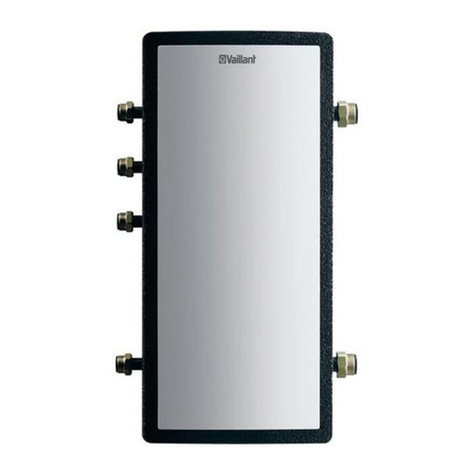
Vaillant
Vaillant VWZ MPS 40 installation instructions
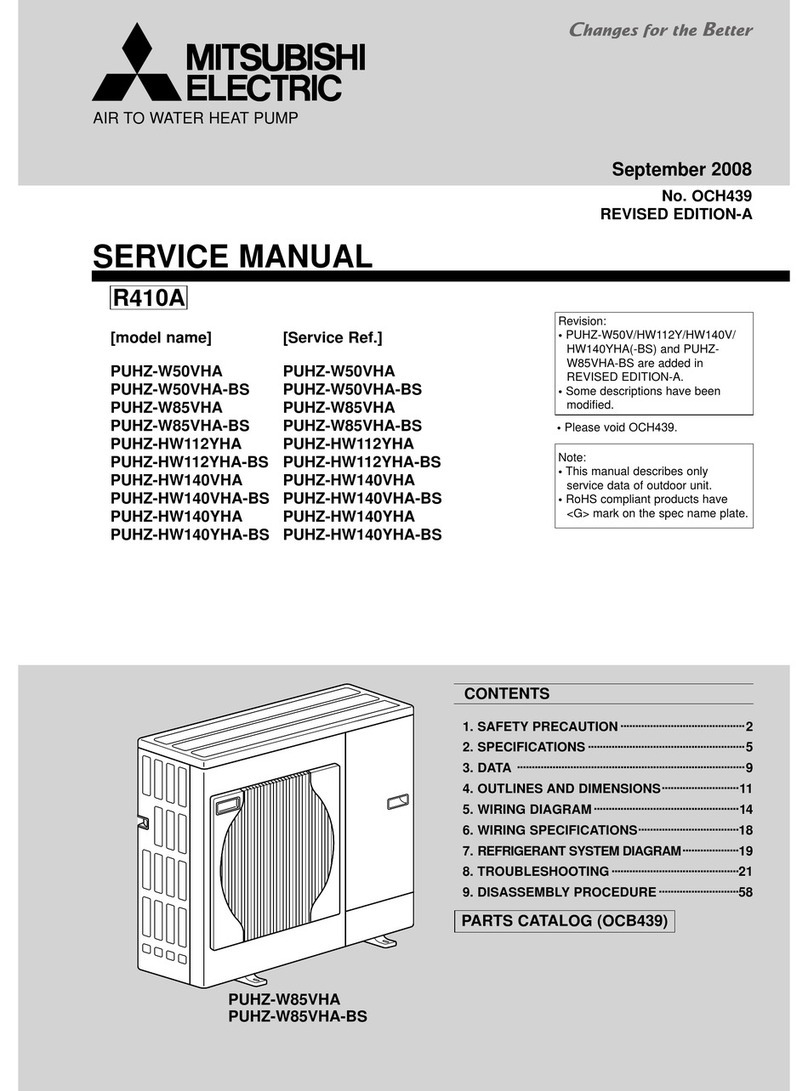
Mitsubishi Electric
Mitsubishi Electric PUHZ-W50VHA Service manual
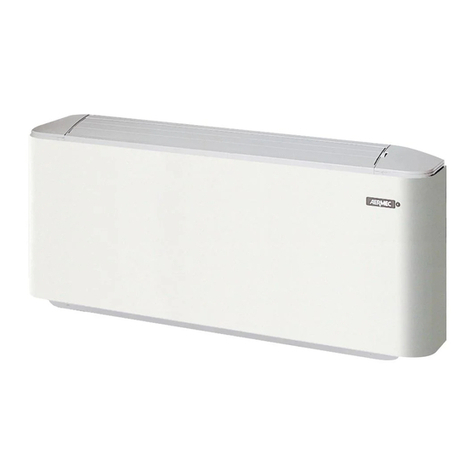
AERMEC
AERMEC Omnia UL PC Use and installation manual
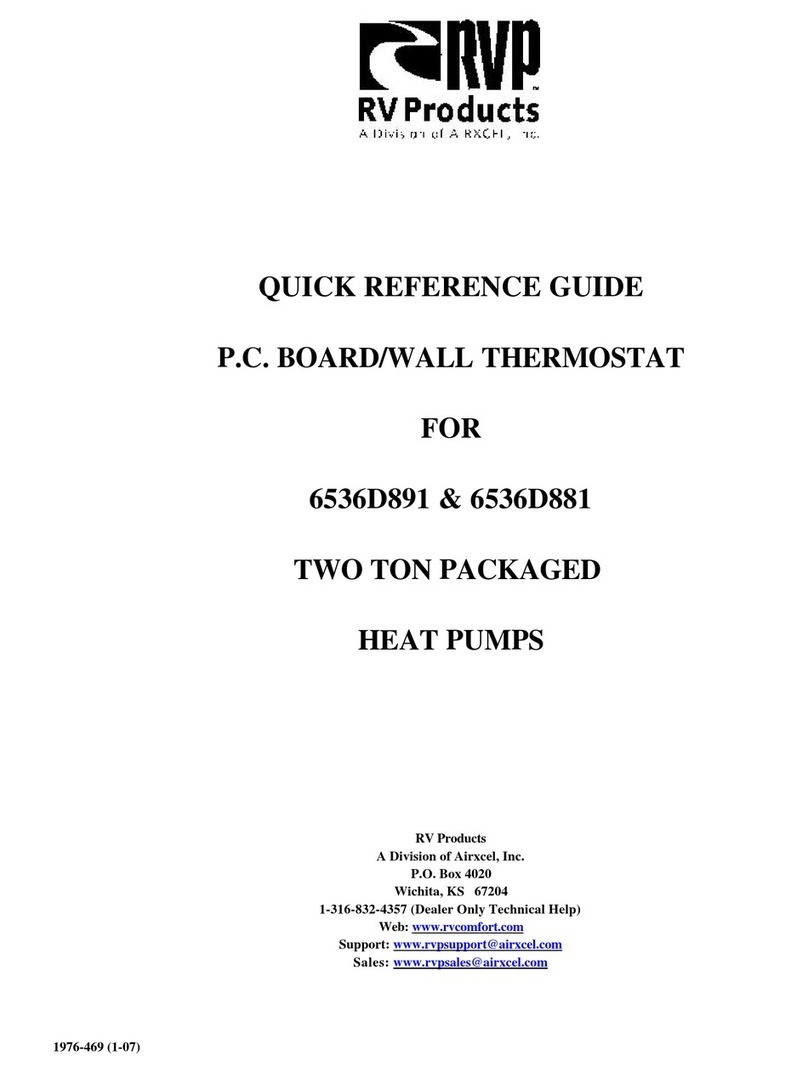
RVP
RVP 6536D891 Quick reference guide

AFRISO
AFRISO PrimoTherm 180-1 operating instructions

Gullberg & Jansson
Gullberg & Jansson GJPASRW-12 Installation and maintenance guide

Carrier
Carrier COMFORT 50EZ-A Product data
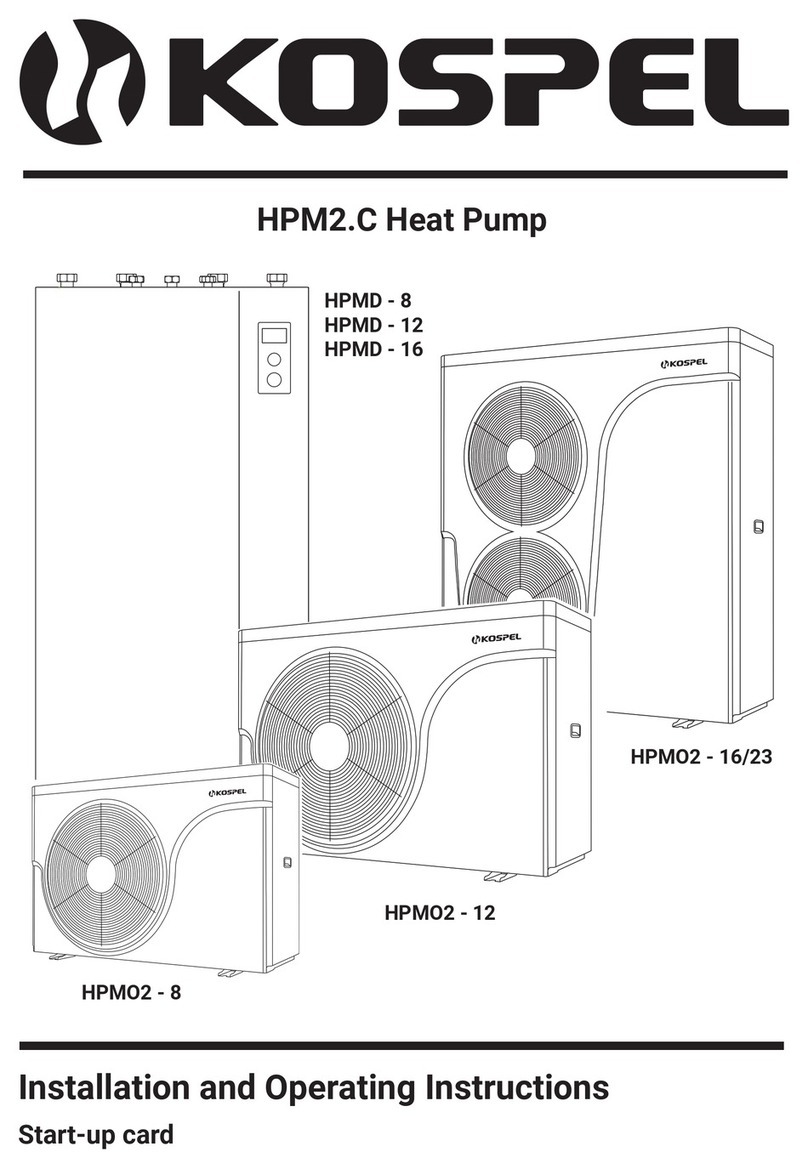
Kospel
Kospel HPM2.C Installation and operating instructions
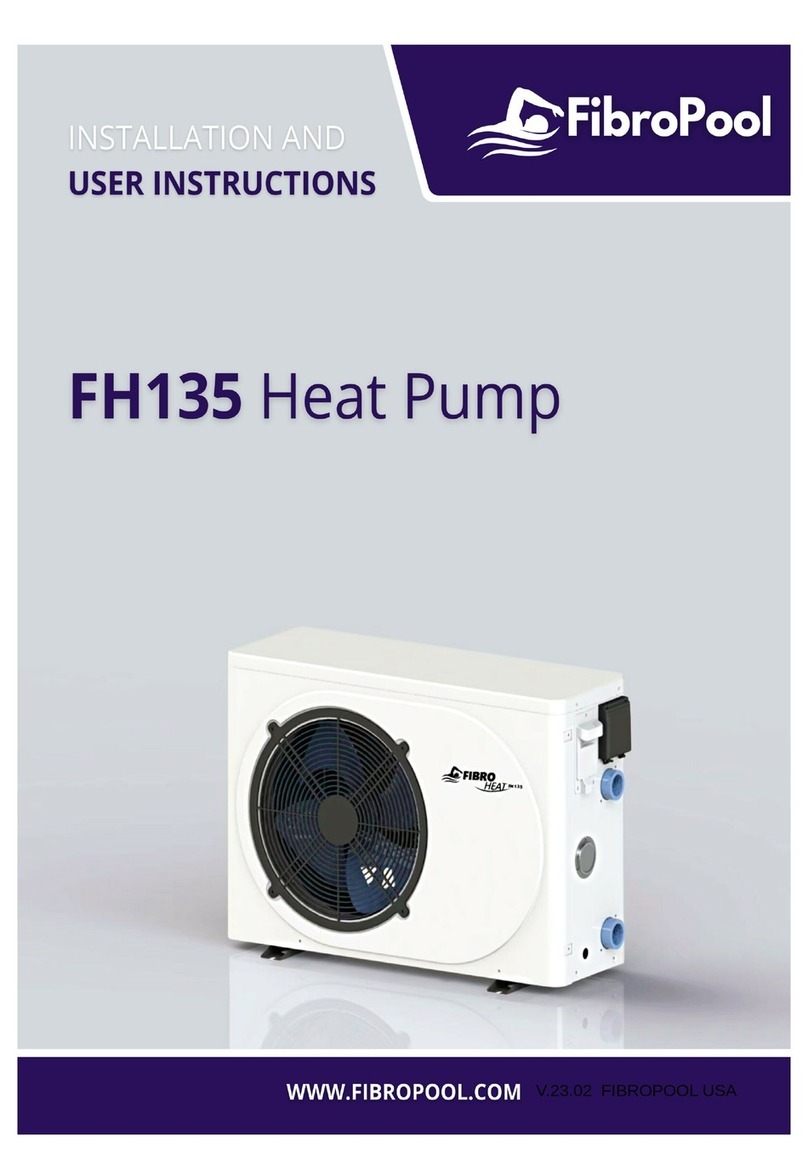
FibroPool
FibroPool FH135 Installation and user instructions
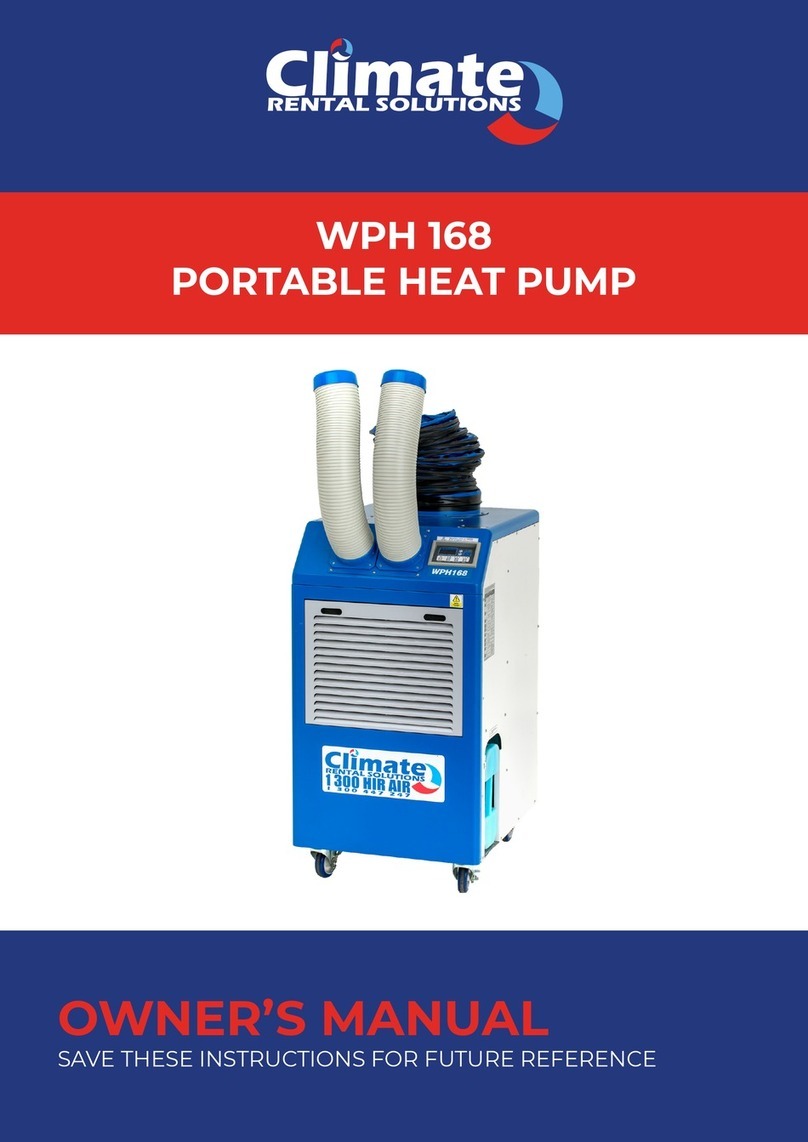
Climate RENTAL SOLUTIONS
Climate RENTAL SOLUTIONS WPH 168 owner's manual

Vaillant
Vaillant geoTHERM VWS Series installation instructions

AIC
AIC TMU 500 Installation and maintenance manual
